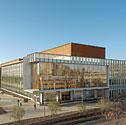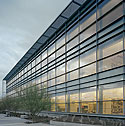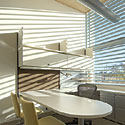Robo Buildings: Pursuing the Interactive Envelope
Active doubles, anyone?
Harder to predict are the benefits of hybrid envelope systems, in which two or more interactive strategies are combined. Many European architects have integrated ventilation, shading, and other active technologies into double-wall facades that serve as primary space conditioners. Unlike Cannon's Occidental Chemical building, early double envelopes had few moving parts. (Some Europeans use the term "active facade" to describe any ventilated double wall, regardless of operability.) More recent projects feature more "edge monkeys": automated hoppers, vents, and shades.
An extreme example is the philology library by Foster and Partners at Berlin's Free University, completed last year. The four-story, orblike enclosure-with an underfloor air plenum-is engineered for free cooling for about seven months of the year using natural ventilation. A checkerboard cladding of aluminum and glazed panels protects an inner glass-fiber membrane. Operable panels close during cold weather, and fresh air is drawn from outside through the floor cavity and into the envelope void. A concrete internal structure provides thermal mass and radiant cooling and heating of recirculated air. The client expects about 35 percent energy savings over a comparable facility.
Hopefully, performance data will bear this out. But unlike Foster's 1997 energy-miser Commerzbank Tower in Frankfurt, most large-scale projects don't document utility costs. Karl Gertis, a building physics researcher at the University of Stuttgart, thinks it's because they often miss the target. In the design phase, simulations prove notoriously unpredictable, he believes. Once built, natural ventilation often isn't adequate for room air handling or for maintaining comfortable temperatures. Weak convective airflows in wall cavities may preclude the use of insect screens and air filters, too. Last, Gertis cites numerous buildings designed without mechanical cooling that have failed. Foster's library stands prepared: On hot days, it leeches supplemental cooling from an adjacent structure.
For Plantation Place, a large office development in London, Arup Associates incorporated active solar shading and occupant-controlled operable ventilation in its double-skinned cladding design. At their lower levels, the buildings have a heavy curtain of limestone fins in deference to the masonry expression of the project's Neoclassical neighbors. Upper levels, on the other hand, are all glass, yet those floors can be cooled with only natural ventilation during much of the year. The outer layer of the 2-foot-deep double walls comprises a rain-and-wind screen of shingled, frameless glass panels, angled at 3 degrees, with open joints. Behind it is a maintenance walkway and solar blinds adjacent to an inner window wall with operable panels. The two layers were delivered to the job site as 5-foot modules and prefabricated on-site into units with integral blinds and catwalks.
To ensure that occupants enjoyed the benefits of the complex facades, Arup Associates and facade engineers from Arup planned an unusual daylighting scheme. In each tenant zone, photosensors were mounted on inner facades to automatically control the raising and lowering of blinds based on local conditions. "There are reliability questions for automated daylighting control," admits Arup facade engineer Neil McClelland. "Any design should recognize that there will be issues and allow for access to the blinds for cleaning and maintenance." McClelland adds that the main reason to use automated blind controls is for maximum transparency, not energy-efficiency.












